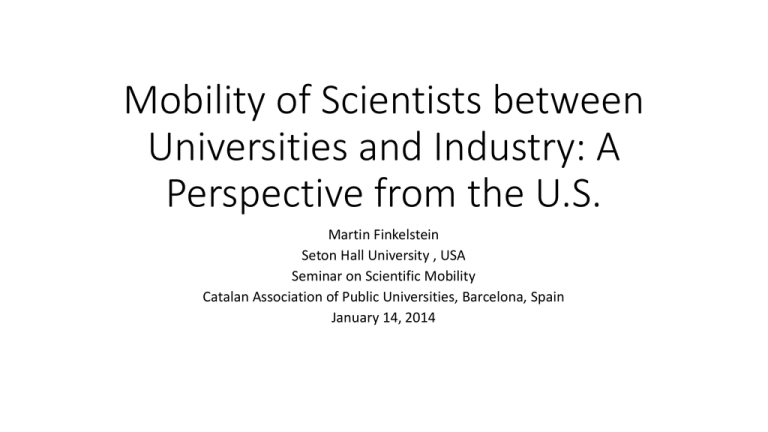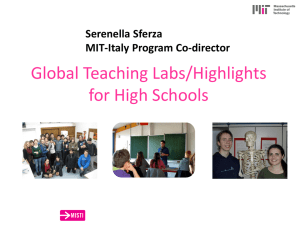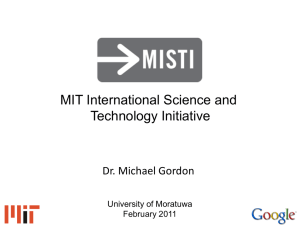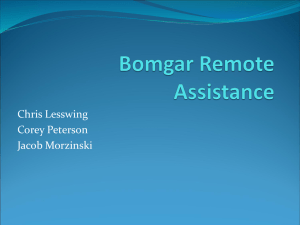Mobility of Scientists between Universities, Government and
advertisement

Mobility of Scientists between Universities and Industry: A Perspective from the U.S. Martin Finkelstein Seton Hall University , USA Seminar on Scientific Mobility Catalan Association of Public Universities, Barcelona, Spain January 14, 2014 My Point of Departure • Is mobility of scientists between universities and industry an “end” in itself? Or rather a means to the larger end of strengthening the linkages between the cutting edge of basic science and the innovative capacity and economic competitiveness of industry? • I begin by assuming the latter and that assumption shapes this presentation in several ways A reformulated set of questions • How can research and development focused on innovation be optimally organized to make the best, most timely use of the most current, “cutting edge” science and technology? • What role do individual scientists play within different organizational structures and what challenges do they face? • How can universities train PhDs for these new roles and re-imagined careers? • What are effective strategies for operationalizing structures and policies? (assuming policies are not “self-executing”) Plan for this Presentation • Historical models of R&D organization • Status of R&D and research careers in the U.S. • R&D in Spain and New Developments in University-Industry Collaboration • New Organizational Structures in the U.S. • Industry • Universities • The Case of MIT • Some Lessons about making things work • Some Questions for You! Three Models of R&D Organization (Lam, 2004) • Technology push model (1960s and 1970s) • Corporations invest in centralized, relatively autonomous R&D units staffed by full-time, career scientists recruited from universities e.g. Bell Labs • Introduction of a “technical” career ladder and prospects for long-term job security • Gave rise to classic conflict between scientific/professional and managerial goals and values –loosely coupled connection between science and product development • Market pull model (1980s and 1990s) • Decentralization of R&D into individual business units and market relationship established between R&D(suppliers) and business division as customer • Scientist required to work in multi-disciplinary teams (with product developers, marketers, etc) and assume some technocommercial responsibilities • Distinct “technical” career path yields to “hybrid” career options, including project-to-project and mixed technicalmanagerial roles and recruitment challenges for top talent • Network model (2000+) • R&D collaboration with universities and outside research organizations via permeable organizational structures that reciprocal information flow • Ad hoc teaming of academic and industry scientists and negotiation of info sharing norms • New kinds of career structures and new kinds of PhD socialization What kinds of organizational structures, career tracks and training experiences can we develop to operationalize the network model? • What kinds of organizational structures will encourage the sort of seamless boundary crossing –back and forth – that we seek? • What kinds of roles and career tracks can be designed to attract the best scientists to these “networked” organizational entities? • What kinds of training and socialization during doctoral study would develop the kinds of predispositions and skills to allow scientists to play these “new” kinds of roles and be attracted to these “reimagined” careers? The situation in the U.S. • What do we know about mobility of scientists –rates and patterns -between industry, government and universities -- based on National Study of Postsecondary Faculty (U.S. Department of Education) and the Survey of Doctoral Recipients (National Science Foundation)? • What do we know about organizational structures in universities and industry that promote the flow of knowledge and scientists across sectors? • What do we know about the changing roles of scientists and the emergence of new kinds of career options? • What do we know about doctoral education and how it is adapting to the likely career situations of PhD recipients? The basic R&D context • In 2011, the US spent 2.7% of GDP on R&D activities accounting for more than one-third of all global R&D expenditures • The relevant sectors in which research careers are pursued include: the private, industrial sector (IND) • the private, non-profit sector (PNP) • the Academic or university sector, both private and public (ACAD) and • the Federal Government sector(FED) • Industrial sector is the driving force for research, in terms of level of overall expenditures. In 2011 nearly 71% of all R&D monies will be spent in the Industrial sector, 14% in the Academic sector, 4% in the private non-profit sector and 7% in the federal government sector • If smaller in dollar terms, the Federal government has a broader mission, funding research within its varied agencies (e.g. NIH, CDC) and awarding grants to academic institutions to support contract research. • Within academia, academic medical centers (AMC) provide a large and diverse arena for lifescience research U.S. research careers within the R&D structure • Research careers in both the Public and Private sector (business and government) fall within two main tracks: • Scientist (or technical) tracks aim to develop research scientists into expert, senior scientists. The majority of their work is investigative in nature and is primarily funded by the organization in which they are employed, or through public and/or private grants. • Manager ( or administrative) tracks typically take mid-level scientists, who have indicated a desire to move into management responsibilities and provide them training and experience in managing R&D staff, associated projects, financial components and the strategic planning and development of future research projects. Typically, research managers are paid by the organization solely. • The Academic sector also has two distinct tracks: • Scientist tracks proceed much the same way as in the private Industrial sector . Duties are largely research based. However, significant funding usually comes in the form of public or private grants, with some funding/salary provided by the organization. • The Professor track includes the typical teaching, research and service duties required of faculty in an institution of higher education. Further, • Dual appointments, especially between academia and the federal government (occasionally the industrial sector) are possible • Typically, these situations arise from a senior or expert level scientist at a public or private organization who wishes to also serve as a faculty member at an institution. These “joint” appointments afford the research scientist an opportunity to teach within his/her field of expertise and are temporary in duration, are generally accompanied by a non-career ladder rank(e.g. research professor) that does not afford them the possibility of tenure. • Conversely, some faculty members may serve as scientists for certain private organizations or government entities on a selected basis. Such arrangements are usually made due to the faculty member’s expert status in a particular field and are not usually permanent placements (e.g. Chief Scientist at NASA who is a professor at the University of Colorado or Director of the Jet Propulsion Laboratory ( a CalTech professor and administrator) Basic production of knowledge workers in U.S. • ~ 48K PhDs annually, ~32K in S&E fields (another 100K terminal professional degrees, e.g. DBA, DLL, MD, EdD, PsyD) • Among PhD recipients, ~ ½ report 1st job placement in academe; `1/4 in industry and 1/10 in government and the non-profit sector • Considerable variation by discipline: in humanities, 4/5 enter academe; in engineering, 1/5 while 2/3 enter industry ; in physical sciences ~ 1/3 enter academe; ~ ½ enter • Rise of post-doc appointments: ~ ½ S&E PhDs now begin with post-doc appointments (increasing length and often successive post-docs);while most frequently funded by federal dollars, they are employed in both academic, government and industrial settings (Can I get distribution across sectors?) U.S. mobility rates and patterns • ½ S&E PhDs begin in post-doc appointment in varied sectors • Recent extension of post-doc tenures and mobility from 1st to 2nd • During immediate post-doc phase, some reciprocal flow between the contingent academic labor market and stable, full-time positions in industry, government and non-profits as well as to non-faculty positions in the academic sector • Insert data from SDR on job mobility, including inter-sector mobility • Once tenured in the academic sector, relatively rare to move permanently outside (except to joint ventures); once establoisging a career industry, relatively rare to move to academe The R&D situation in Spain: Basic context • 2020 Goal: R&D as 3% of GDP (1% public; 2% business) • In 2011, R&D was 1.33 % of GDP (public 0.64; business 0.70) • Business R&D expenditures peaked in 2008 , more than doubling in real terms over the period 2000-2008. • As a result of European economic crisis , business R&D investment fell by 6.27% in 2009 and by another 0.81% in 2010. • Stock or researchers ~10-15% below European average • 9.7 vs. 10.2 headcount per active labor force • 5.8 vs. 6.6 FE per active labor force • Large regional variation New R&D developments in Spain Spanish Science, Technology and • The Science, Technology and Innovation Strategy is a 7-year strategy approved by the Spanish Government on 1 February 2013. It aims, among other overarching objectives, to acknowledge and promote talent in R&D&I and to promote researchers’ employability. To achieve that goal, its specific objectives are to train researchers, to foster mobility and promote career development, and to multiply career opportunities for researchers. • The plan implements the Science, Technology and Innovation Strategy (see above) until 2016. Specifically aimed at training researchers, the plan includes measures to promote doctoral training in cooperation with industry, and entrepreneurship as well as to promote research management training. To foster mobility and promote career development, the plan encourages researchers from public institutions to spend some time working in the business sector. Innovation Strategy (2013-2020) State Scientific and Technological Research, and Innovation Plan (ongoing-2016) University 2015 Strategy • The University 2015 Strategy is a Spanish Government initiative for modernising universities in Spain through the coordination of the autonomous regional university systems and the development of a modern Spanish University System. The Strategy promotes research activities and innovation in Spanish universities while encouraging training activities and knowledge transfer from the academic world to companies. • Law on Science, Technology and Innovation (2011) Prescribes a stable and predictable science career for researchers as well as a more efficient and effective R&D system. The law contains provisions to foster partnerships between academia and industry and regulates mobility patterns between New R&D developments in Catalonia Plan for the Researcher’s Career in Catalonia (2005) The 2010-2013 Research and Innovation Plan (PRI), Catalonia • The Plan for the Researcher’s Career is an initiative at regional level aiming at developing strategies and instruments to increase the number of researchers in Catalonia, encourage researchers’ career development in both the public and private sectors, and researchers’ mobility between countries, and between academia and business. • The Research and Innovation Plan is an initiative at regional level aiming to plan, promote and coordinate Catalonia's research and innovation. The Plan is also the fundamental instrument for maintaining the development of the 2008 Catalan Agreement on Research and Innovation (PNRI)over this four year period. The Nature and scope of the challenge • While the initial challenge is to develop new policies and enabling legal context, the next –and perhaps greater – challenge is to make them work! • We have all heard of the cultural chasm between the academic and business sector • Goals • Values • Open access vs proprietary • How do we engage university academic staff in working with industrial scientists and their organizations? • How do we engage industrial scientists in working with their academic counterparts? • How do integrate new skills and dispositions into doctoral education? First, New organizational structures in the U.S. • Previously dominated by large multi-national pharmaceutical, chemical, technology and energy companies, industrial sector now includes smaller biotechnology companies, contract research organizations, etc • Universities are increasingly developing start-up incubation parks on or adjoining their campuses, investing in faculty spawned start-up companies, establishing collaborative research programs with industry and developing technology transfer infrastructures • Individual academics are seeking venture capital investment and small firm financing programs like the U.S. Small Business Innovation Research (SBIR)Program. • Government and the non-profit sector are promoting university-industry collaboration through on-going University-Business forums, start-up financing programs (SBIR above) New training models • Entrepreneurial skills, including strategic/project planning, management and fund raising; multidiscplinary team building skills • Opportunities for student mobility during doctoral study (e.g. internships) • Opportunities for industrial scientist participation in doctoral education • Collaborative research projects between university and industrial scientists and boundary spanning structures Some examples or models: U.S Industry • Establishing collaborative research relationships with individual universities in specific areas. These relationships include: • Short-term opportunities (up to one year) for academic staff working in areas of joint interest to work in an industrial lab (with funding) and bringing graduate students along; • Offering industrial scientists to cooperating university to teach individual courses or perhaps severe on doctoral committees • Sponsoring post-docs for new graduates • Entering into ad hoc partnerships for the commercialization of new technologies developed at the university (University technology transfer offices) • Requiring industrial scientists to devote 10-15% of work time to “personal” research projects • SOP at 3-M, Johnson& Johnson, IBM, Pfizer, Exxon Boundary-Spanning Organizational Structures in Universities • Most U.S universities have a Vice President for Research who manages all contract research (one of perhaps a dozen VPs for academic affairs, financial administration, government relations, fund-raising, student affairs, etc) • Within this Contract Research Unit, there is usually a Technology Transfer Office whose role is to develop agreements with industry (including negotiation of intellectual property rights) for bringing to market faculty research results and inventions as well as applying for patents • There may also be an industry liaison office MIT as a Model of University-Industry Partnership • Currently over 700 companies are working with faculty and students on projects of mutual interest. Among these corporate sponsors are such global leaders as BAE, BP, Boeing, Du Pont, eni, Ford Motor, Google, Intel, Lockheed Martin, Novartis, Quanta Computer, Raytheon, Samsung, Sanofi, Shell, Siemens, TOTAL, etc. • MIT has vibrant patenting/licensing activity, with 706 new invention disclosures in FY12, and $148 million in total licensing revenue. It has a Technology Licensing Office (TLO) that moves the results of MIT research into societal use via technology licensing, through a process which is consistent with academic principles, demonstrates a concern for the welfare of students and faculty, and conforms to the highest ethical standards. This process benefits the public by creating new products and promoting economic development. It helps MIT: . • According to a 2009 Kauffman Foundation Entrepreneurship Study, 25,000+ companies have been founded by MIT alums creating 3.3+ million jobs and $2 trillion in annual world sales. • MIT established the Deshpande Center at the MIT School of Engineering in 2002 to increase the impact of MIT technologies in the marketplace, and supports a wide range of emerging technologies including biotechnology, biomedical devices, information technology, new materials, tiny tech, and energy innovations. Since 2002, The Deshpande Center has funded more than 80 projects with over $9 M in grants. Eighteen projects have spun out of the center into commercial ventures, having collectively raised over $140 M in outside financing. Thirteen venture capital firms have invested in these ventures • MIT sponsors a search engine that allows any corporation to search the research currently being conducted by MIT faculty ans students MIT’s Office of Corporate Relations • MIT’s Office of Corporate Relations aids and directs companies interested in pursuing significant, multi-year, multi-disciplinary involvement with the Institute. OCR's expert staff works with MIT senior administration, faculty, and company executives to structure and define individualized alliances that mutually benefit the company and MIT. The result is a holistic industry/university relationship that addresses broad needs and interests, from specific research projects and initiatives, to executive education, technology licensing, and recruitment. • OCR, the organizational parent of the Industrial Liaison Program at MIT, can be instrumental in providing connections to MIT faculty, departments, labs, and centers. It serves companies across the globe and is organized both geographically and by industry. In addition to corporate partners, OCR also helps regional governmental organizations who look to the unique, entrepreneurial MIT/Cambridge environment as they begin to develop their own regional innovation eco-systems. MIT’s Industrial Liaison Program (ILP) • Established in 1948, ILP, has worked with 200+ companies worldwide, and offers corporate “memberships” • As a corporate member, MIT assigns an “Industrial Liaison Officer (ILO) to the member company based on his/her knowledge and understanding of your industry. Whether focus of corporate client is exploratory and spontaneous, or narrowly focused and structured, the ILP works to develop an individualized member “Action Plan” • General objectives of an ILP Action Plan are to: • • • • • Prioritize interest areas Identify ideal company participants, stakeholders Develop objectives for MIT interactions Schedule specific activities involving interactions with faculty researchers, labs and centers Provide ongoing assessment, advice on next steps • An ILP Action Plan typically calls for managers and researchers from a company to visit the MIT campus several times a year, actively participating in a series of meetings with MIT experts. All interactions are professionally developed and organized by the ILP. ILP (con’t) • Initial discussions between ILP members and MIT faculty often lead to significant sponsorship of research, involving much more frequent and complex MIT linkages, often involving multi-disciplinary teams. The ILP advises on reaching consensus with principal investigators on the specific area of research interest, aids in assembling the project team, serve as a central point of contact and coordination, and act as a catalyst for progress. • At any given time, about 1/3 of ILP members are actively sponsoring research at MIT. The ILP has included MIT collaborations with corpoorations such as BP, British Telecom, Du Pont, Eni, Microsoft, Novartis, Quanta Computer, Tata Chemical. So, in the case of MIT, a multifaceted program of industry interface • A search engine /information clearinghouse for research in progress • A corporate membership program that includes client-oriented services • An well-staffed office of liaison to industry • A technology transfer office • An internal innoivation development fund What allows this to work? • Structures and mechanisms , including a “common space” available to bring people together • Collaborations are forged at the individual level and require individual motivation to initiate and sustain • Focus on interests of clients and MIT faculty (ground-up) • Incentives built in for the university and its faculty (revenue) and clients (who can get research done at a fraction of the cost of doing it themselves) • Provide concrete experiences across settings that are short-term, but intensive • Be flexible with project design and management (responsive to changing and unanticipated needs What motivates faculty and what sustains their collaborative efforts • They are working on projects that matter to them, the build on previous work or relationships [grassroots] • They see the clear individual career benefits, esp in terms of contributing to future productivity • There is clear departmental (and broader institutional) involvement and support • There is considerable flexibility in project design and management ( responsive to unanticipated needs) • Graduate students are involved; and Some questions for you • How have Spanish or Catalan industries historically employed PhD recipients? What % of Spanish PhDs work in industry? • What kinds of linkages currently exist between individual universities and individual business corporation? In what industries? Energy? Chemical? Pharmaceutical? • How have universities responded organizationally to the new laws and strategic initiatives of the national and regional government? • What about Spanish scientists and engineers? What % are involved currently in work with industry? • How does our discussion today apply to the Catalan case? Thank you!






